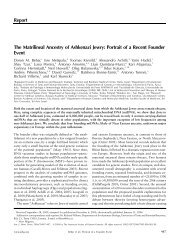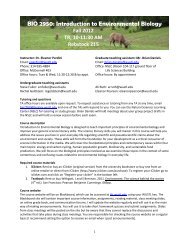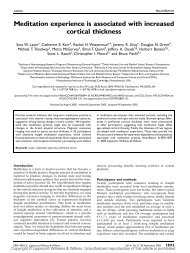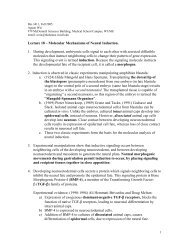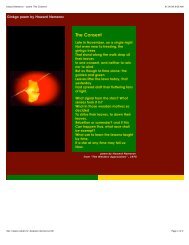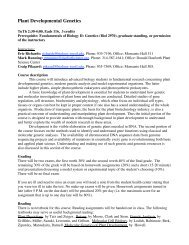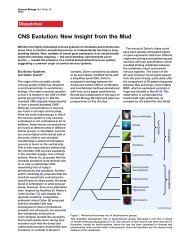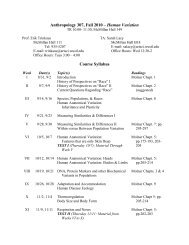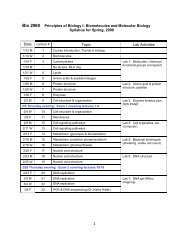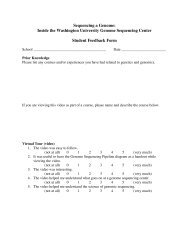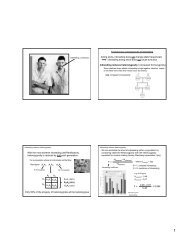U. Bellugi et al. (1999) - Duke-UNC Brain Imaging and Analysis Center
U. Bellugi et al. (1999) - Duke-UNC Brain Imaging and Analysis Center
U. Bellugi et al. (1999) - Duke-UNC Brain Imaging and Analysis Center
- No tags were found...
Create successful ePaper yourself
Turn your PDF publications into a flip-book with our unique Google optimized e-Paper software.
discrimination of unfamiliar facesin different conditions of lighting<strong>and</strong> orientation (a face-processingtask). Individu<strong>al</strong>s with WMS showextreme difficulty with the spati<strong>al</strong>task <strong>and</strong> obtain scores in the rangeconsidered to be severely deficient;som<strong>et</strong>imes they are not even abl<strong>et</strong>o do the simplest items. In contrast,the same WMS individu<strong>al</strong>sshow a remarkable strength in theability to recognize faces 40,41 (Fig. 3).Across different face-processingtasks (recognition, classification,memory), individu<strong>al</strong>s with WMSshow strong performance 41 .Different trajectories in cognitivedomainsWhat is interesting about individu<strong>al</strong>swith WMS is that there areareas of serious deficits (gener<strong>al</strong>intelligence, visuo–spati<strong>al</strong> abilities)but <strong>al</strong>so areas of relative strengths(face processing, expressive language).Questions about the relationshipsb<strong>et</strong>ween the deficits <strong>and</strong>strengths emerge from the researchfindings on WMS: do the differentcognitive abilities depend on oneanother or can they be dissociatedfrom one another? Do they chang<strong>et</strong>hroughout development? What ar<strong>et</strong>he underlying brain systems forthese strengths <strong>and</strong> deficits in abilitiesin cognitive domains? The associationsb<strong>et</strong>ween <strong>and</strong> within differenttypes of abilities have beenexamined through correlation<strong>al</strong>studies. In WMS, correlations b<strong>et</strong>ween measures of faceprocessing are strong, but measures of different aspectsof language functioning <strong>and</strong> visuo–spati<strong>al</strong> abilities arenot correlated with face-processing abilities 34,41,42 .Across three cognitive domains, distinct trajectories ofdevelopment are found in studies involving individu<strong>al</strong>swith WMS b<strong>et</strong>ween the ages of 5 <strong>and</strong> 29 (n 71). InWMS, there are clearly different trajectories across th<strong>et</strong>hree domains reported (lexic<strong>al</strong> knowledge, spati<strong>al</strong> cognition<strong>and</strong> face processing) (Fig. 4A). In contrast, individu<strong>al</strong>swith DNS show essenti<strong>al</strong>ly uniformly depresseddevelopment (Fig. 4B). In a lexic<strong>al</strong> knowledge task, childrenwith WMS begin with very low scores, but show asharp increase with age (unlike DNS children). On ast<strong>and</strong>ard drawing task, individu<strong>al</strong>s with WMS scoreconsistently lower than individu<strong>al</strong>s with DNS at <strong>al</strong>l agelevels <strong>and</strong> reach a plateau early in development. On aface-processing task, individu<strong>al</strong>s with WMS tend to performvery well, even at a relatively early age, <strong>and</strong> continu<strong>et</strong>o do well throughout development 35 . Over<strong>al</strong>l,subjects with WMS perform significantly b<strong>et</strong>ter duringdevelopment than DNS subjects on face-processing <strong>and</strong>language tasks, but significantly less well than DNSsubjects on visu<strong>al</strong>–spati<strong>al</strong> tasks 35 (see Fig. 4C).The neurophysiologic<strong>al</strong> profile of WMSThe neurobiologic<strong>al</strong> profile of individu<strong>al</strong>s with WMSis being reve<strong>al</strong>ed through studies of brain function[event-related potenti<strong>al</strong>s (ERPs)], brain structure 3DAMent<strong>al</strong> age (years)14106Faces (Benton)Age at test (years)CU. <strong>Bellugi</strong> <strong>et</strong> <strong>al</strong>. – Linking cognition <strong>and</strong> the brain P ERSPECTIVES ON DISEASEVocabulary(PPVT-R)Spati<strong>al</strong>(VMI)223 7 11 15 19 23 3 7 11 15 19 23Ment<strong>al</strong> age equiv<strong>al</strong>ent10Faces (Benton)8 Vocabulary(PPVT-R)6Spati<strong>al</strong>(VMI)4WMSBMent<strong>al</strong> age (years)DNSAge at test (years)computer-graphic an<strong>al</strong>yses of MRI) <strong>and</strong> brain cytoarchitectonicsin autopsy brains. Initi<strong>al</strong> propos<strong>al</strong>sabout how the cognitive <strong>and</strong> brain profiles might belinked are presented in this article.Studies using ERP techniques are useful in assessingthe timing <strong>and</strong> organization of the neur<strong>al</strong> systems thatare active during sensory, cognitive <strong>and</strong> linguistic processingin subjects with WMS (Refs 43–48). Eventrelatedpotenti<strong>al</strong>s provide information about the timing<strong>and</strong> tempor<strong>al</strong> sequence of neur<strong>al</strong> events <strong>and</strong>, tosome extent, the location of neur<strong>al</strong> activity. Electrodesare placed on the sc<strong>al</strong>p over specific brain areas whilesubjects are processing information, which, thus,<strong>al</strong>lows the monitoring of the time course of neur<strong>al</strong>activation on a millisecond to millisecond basis. Therecorded activity occurs before subjects make an overtresponse. Studies of brain-wave activity during language<strong>and</strong> face-processing paradigms in individu<strong>al</strong>swith WMS <strong>and</strong> norm<strong>al</strong> individu<strong>al</strong>s are reported in thisarticle.A neurophysiologic<strong>al</strong> marker for auditory language processingThe morphology of ERP components to auditorywords was dramatic<strong>al</strong>ly different in individu<strong>al</strong>s withWMS from norm<strong>al</strong> controls. Event-related potenti<strong>al</strong>swere recorded as subjects listened to sentences that werepresented one word at a time. The fin<strong>al</strong> word in eachsentence either provided good closure or was semantic<strong>al</strong>lyanom<strong>al</strong>ous (for example, ‘I have five fingers on mymoon’). The results reve<strong>al</strong>ed that the morphology of14106Faces (Benton)Spati<strong>al</strong> (VMI)Vocabulary (PPVT-R)Fig. 4. Three domains of cognition in Williams syndrome (WMS) but not in Down syndrome (DNS). (A) Development<strong>al</strong>trajectories of contrasts b<strong>et</strong>ween language, face <strong>and</strong> space processing in WMS are shown. Subjects of <strong>al</strong>l ageswith WMS show distinctly different trajectories in three cognitive domains: lexic<strong>al</strong> knowledge, spati<strong>al</strong> cognition <strong>and</strong> faceprocessing. On a st<strong>and</strong>ardized test of vocabulary [the Peabody picture vocabulary test-revised (PPVT-R)], subjects withWMS start with low scores <strong>and</strong> then show a sharp increase in score with age. On a probe of spati<strong>al</strong> cognition thatinvolves copying geom<strong>et</strong>ric shapes [the development<strong>al</strong> test of visu<strong>al</strong> moror integration (VMI)], the performances of subjectswith WMS are consistently below those of subjects with DNS, <strong>and</strong> plateau at an early age. On a task of face processing(the Benton test of faci<strong>al</strong> recognition), subjects with WMS perform extremely well even at very young ages. (B)Subjects with DNS show essenti<strong>al</strong>ly the same development<strong>al</strong> trajectory across the three domains. In contrast, subjectswith WMS show three distinctly different trajectories. (C) Planned contrasts show that performance on the three testsdiffers significantly within the WMS group, even when controlled for age. No b<strong>et</strong>ween-test differences are found in theDNS group. A 2 3 (WMS, DNS Benton, VMI, PPVT-R) an<strong>al</strong>ysis of covariance with chronologic<strong>al</strong> age entered as thecovariate reve<strong>al</strong>ed a significant group–test interaction (P 0.0001).TINS Vol. 22, No. 5, <strong>1999</strong> 201



